Le Monstre: Coast to Coast in Cunningham’s Head-Turner
For five months—6 a.m. to midnight, seven days a week—Derek Drinkwater’s life was consumed by a race car that competed only once, in the 1950 24 Hours of Le Mans, where it finished a middling eleventh. Drinkwater could never own it: It’s worth too much money, and happily resides in a museum in Naples, Florida, while Drinkwater and his wife, Pat, live in Chiddingfold, England, where he wears several hats—a truck mechanic, a caterer, a race car driver, a popular television host.
The car he’s so taken with is called Le Monstre, French for “the monster,” so named by fans and the media at Le Mans, because the car’s styling is somewhere between cartoonish and hideous.
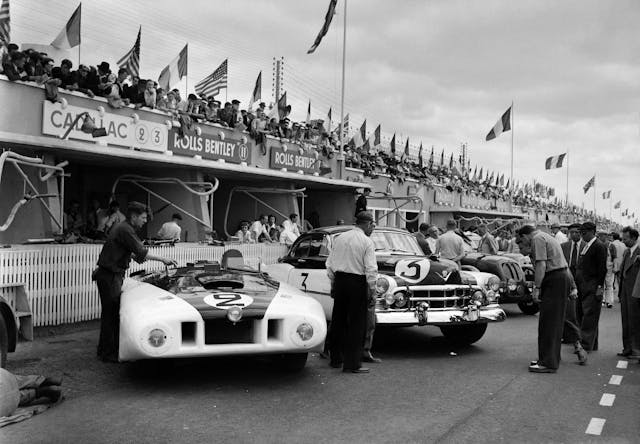
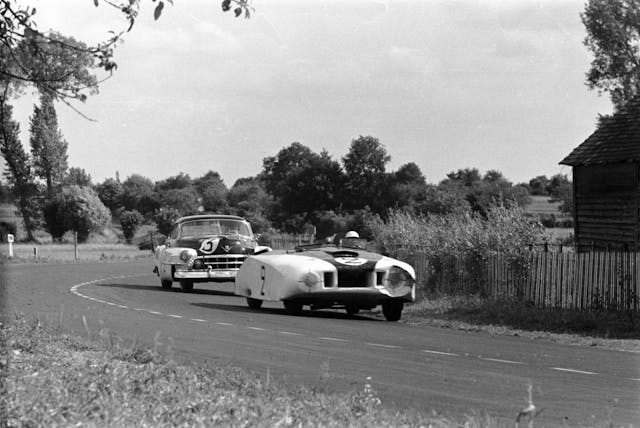
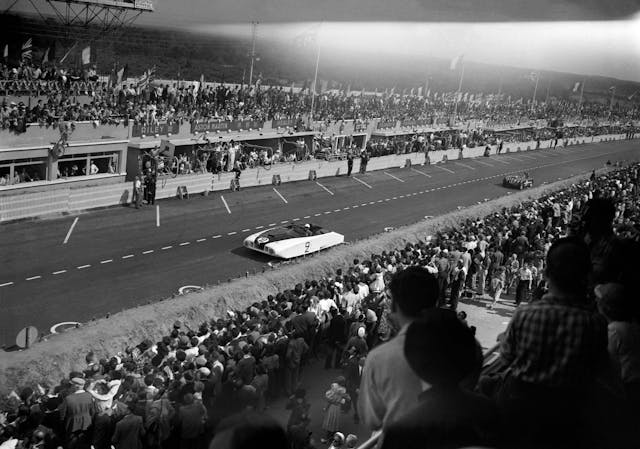
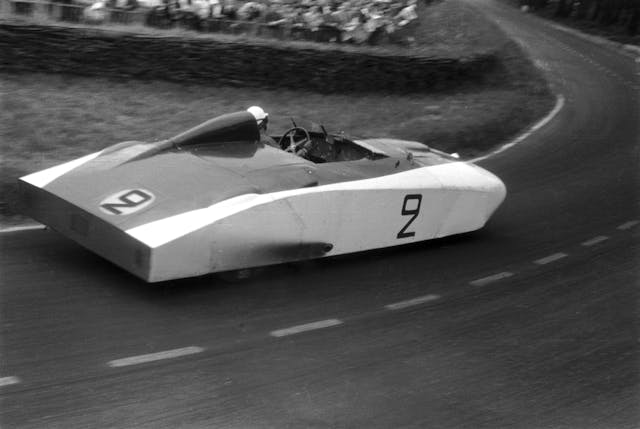
If Drinkwater couldn’t have the monster, he’d just build one. He told Pat that he’d be eating in the garage for a while. She begged him not to do it. “I have to get it out of my system,” he told her.
It’s all the fault of Briggs Swift Cunningham II, who was the sort of man who could make the average Joe feel good about millionaires. Born in 1907, family money funneled into Cunningham’s bank account from a variety of sources: A growing company named Procter and Gamble, the Pennsylvania Railroad, Citizen’s National Bank, the meat packing industry and multiple other businesses. And this was before he married Lucie Bedford, granddaughter of the founder of Standard Oil.
Cunningham didn’t smoke or drink or carry on like the rich people in The Great Gatsby. He preferred to spend his money in competition: He built a boat and sailed it to victory in the 1958 America’s Cup, and—along with college chums he met at Yale, brothers Miles and Sam Collier—he built and raced cars.

Cunningham was already an established racer when a pair of entries for the 1950 24 Hours of Le Mans fell into his lap. You’d think he would just buy a pair of Ferraris or Talbot-Lagos, but Cunningham was different: If he was going to France, he wanted to take something American.
But what? Cadillac was building a potent 5.4-liter, 160-horsepower V-8; stuff that into a short-wheelbase Cadillac Series 61 two-door, and at least you’d have something that might go the distance.
That wasn’t quite enough for Cunningham and his cohorts: Sure, they sent a stock-appearing Series 61 with an auxiliary 35-gallon fuel tank and twin carburetors as one entry, but for the second, Cunningham noticed the rule book said modifications to the body were allowed. He removed the steel body completely and had an engineer at Grumman Aircraft design something in aluminum that would be lighter and more aerodynamic. It looked like a bar of Procter and Gamble soap. The French dubbed it “Le Monstre.”
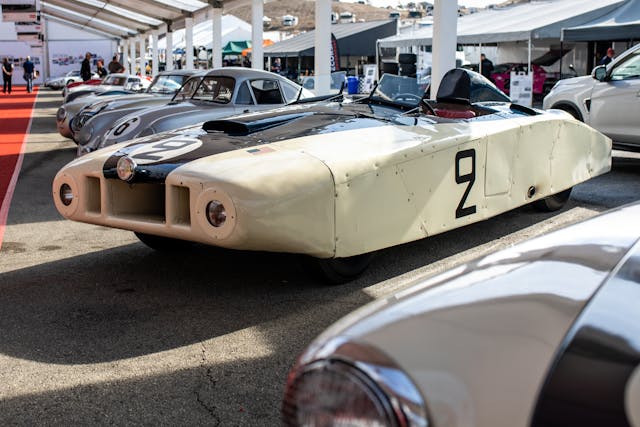
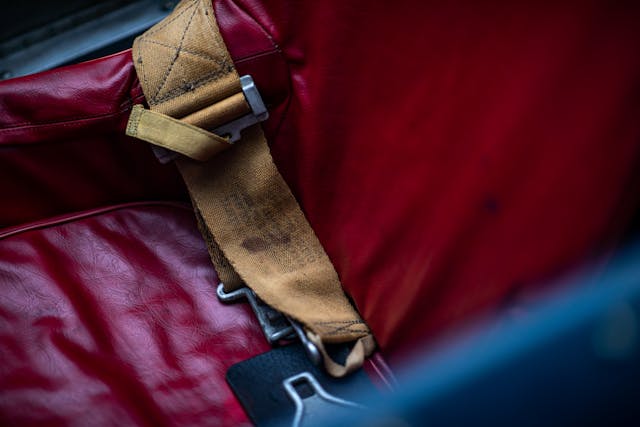
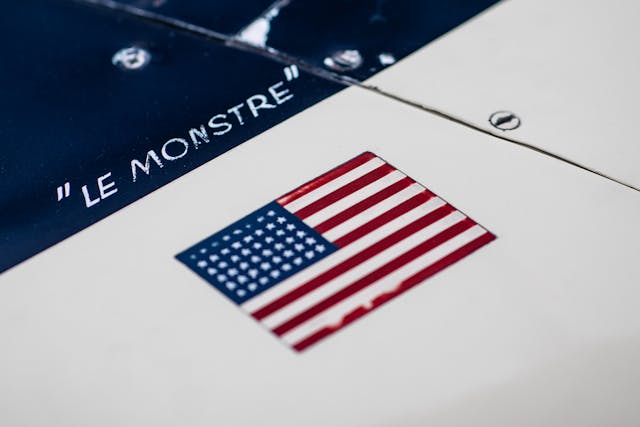
Technical inspectors at Le Mans scrutinized Le Monstre, rule book in one hand, fine-toothed comb in the other. No, the rules didn’t say you could replace the entire body, but they didn’t say you couldn’t. It was judged legal. Cunningham, along with tuner Phil Walters, drove Le Monstre. The Collier brothers drove the other Cadillac, which the French were calling “Petit Pataud,” which translates to “Little Clumsy.”
Little Clumsy finished tenth, while Le Monstre was 11th, a victim of Cunningham stuffing the car into a sand bank early on in the race. It took him about a half-hour to dig the car out by hand.
For some reason, all this resonated with Derek Drinkwater, who usually works on and sells Diamond T trucks, known mostly for the rugged six-wheel vehicles built for use by the military in World War II. He uses vintage trucks in his high-profile catering business, and he also appears on several auto-related TV shows.
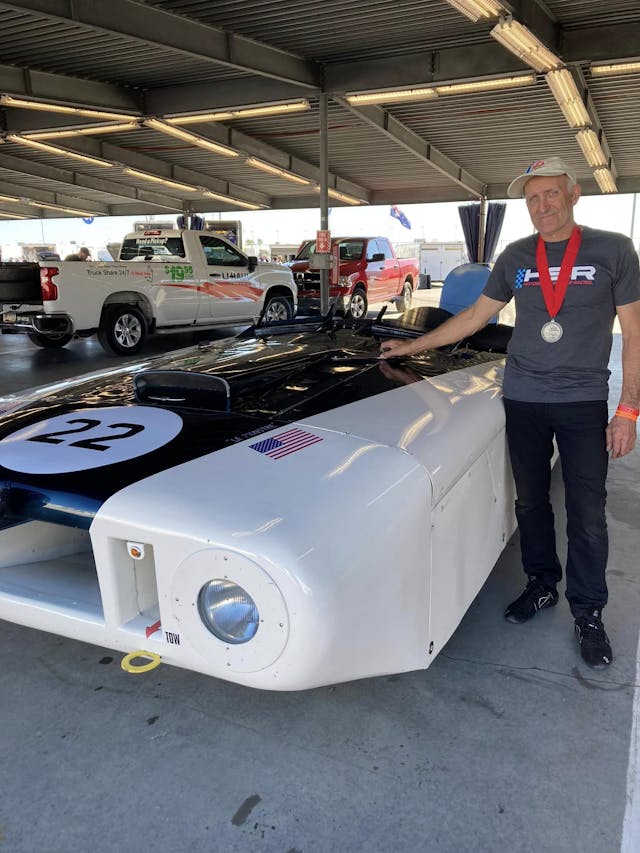
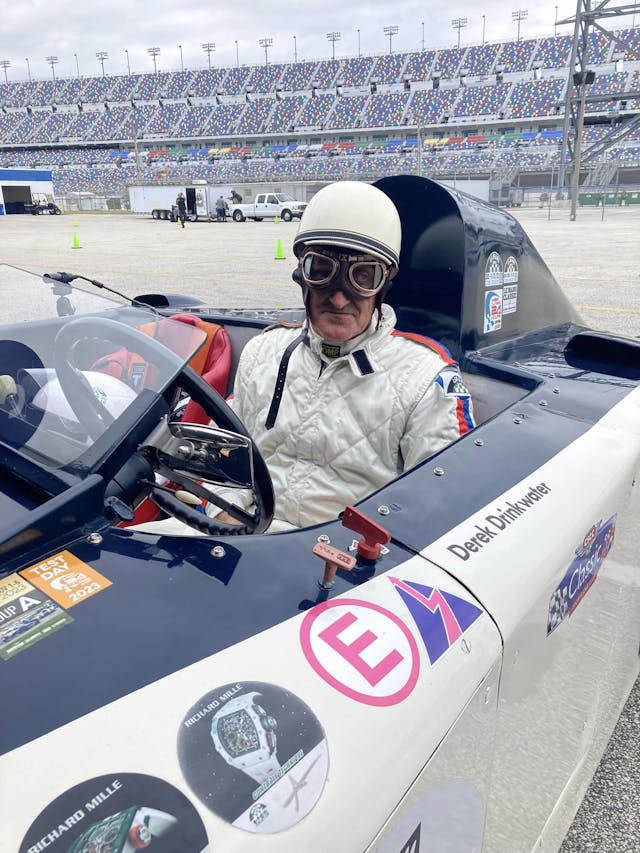
This may not be the first time he has been obsessed with a famous vehicle: He was profiled in a documentary about director Steven Spielberg’s first film, the low-budget, made-for-TV Duel, about a sinister Peterbilt truck that chases a hapless traveling salesman (Dennis Weaver) driving a Plymouth Valiant. In the documentary, titled The Devil on Wheels, Drinkwater says he “fell in love” with the 1971 movie. He found a vintage Peterbilt attached to a tanker like the one in Duel, bought it on eBay, drove it 2700 miles from Portland to Houston, put it on a boat and had it sent on a four-week cruise to England.
So maybe spending five months building a replica of a car that raced once, years before Drinkwater was born, is not that out of character. After all, he had already built and raced a Cadillac like Little Clumsy, but that wasn’t enough.
It was Pat who actually got the ball rolling: She located a short-wheelbase 1950 Cadillac in Arizona. “We bought that and used its chassis,” Drinkwater said. It would not be easy. Le Monstre and Little Clumsy both remained in Cunningham’s considerable car collection, along with subsequent Cunningham-built cars, many with Cadillac engines. That collection fell into the hands of Miles C. Collier, son of Cunningham’s Yale friend and Le Mans team driver, who houses the collection at the Revs Institute in Naples, Florida. The Revs Institute was of great value to Drinkwater, supplying all sorts of photos and measurements of Le Monstre.





But what they didn’t have was any sort of blueprint. So Drinkwater built a big projector and a huge screen, on which he projected a life-sized side photograph of Le Monstre. He outlined the entire car on the screen, matching the appropriate measurements, and effectively made his own blueprint of the car he would build.
Gradually it took shape. Inside, it used the same Cadillac V-8 engine, down to Le Monstre’s odd five-carburetor fuel system with a Carter carb in the middle, surrounded by four Holleys. The same three-on-the-tree shifter and transmission that, incidentally, made downshifting for sharp turns at Daytona a challenge. The same drum brakes. Drinkwater resisted the urge to update the suspension.



Outside, Drinkwater formed the aluminum panels himself, which he admits is not his specialty. The panels were affixed to a tubing framework by airplane-style Dzus fasteners. Rear lights, like the original, come from a 1948 Ford. The factory Cadillac steering wheel was replaced. A small engraved plate placed on Le Monstre’s dashboard, just left of that steering wheel, read “Custom built by Frick-Tappet Motors Inc.,” of Long Island, New York. A nearly identical plate in Drinkwater’s car reads, “Custom built by Derek Drinkwater Motors Inc.” of Chiddingfold, England. The car was painted white with a big blue stripe down the middle, which was a Cunningham staple.





On Facebook, a growing number of people watched Drinkwater’s build take place. He let it be known that he was in search of a special gauge like one used on Le Monstre: Two people responded. The first guy had one he’d sell Drinkwater for $3000. The other guy also had one. He wrote, “I’ve been following you on Facebook. You can have it for what I paid for it 20-odd years ago: $200. I’m honored to be part of the build.”
Drinkwater finished his monster in 2018, and began driving it at some racetracks in Europe, including Brands Hatch and at the Goodwood Festival of Speed. He also raced it at Le Mans, in the Le Mans Classic, a series for vintage cars.

At Goodwood, both the original Le Monstre and Drinkwater’s tribute car showed up, and he had the opportunity to compare them side by side. The tunnel behind the driver’s head, containing the roll bar, is two inches taller and wider than the original, because, Drinkwater said, that’s what the rules require now. And the white on Le Monstre’s body has turned to more of a cream color, likely due to age. Otherwise, they appear to have emerged from the same factory.
Last November, he drove his car at the Classic 24 Hours at Daytona, an annual event patterned after the Le Mans Classic. The event was designed for cars raced in 1965 or newer, but Drinkwater asked the organizers, Historic Sportscar Racing, if they would allow him to come, “and they said, ‘Of course, we’d love to have you.’” His car hit 142 mph in practice, faster than Le Monstre went at Le Mans.


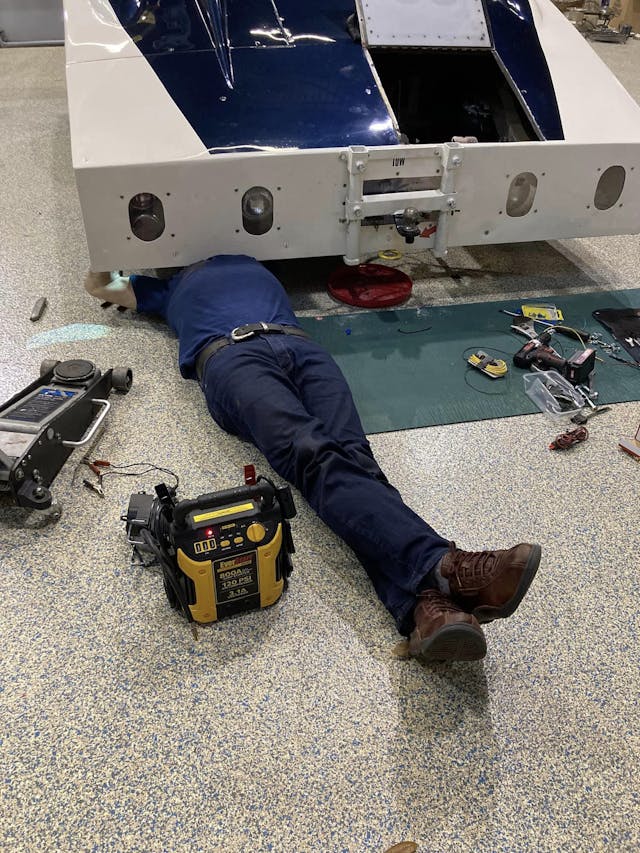

This month he returned to Daytona—his car wintered in Florida—and Drinkwater fabricated a trailer hitch for the car, hooked up a teardrop camper, and he and wife Pat hit the road, leaving Daytona and bound for California. He spoke to Hagerty during a quick stop, about 40 miles east of Austin.
“No roof, no windshield wipers, no heater—what could go wrong?” Drinkwater said, laughing.
“So far, the trip has been fantastic. We’re taking the scenic route.” He and Pat have basically taken a year off from work, so there’s no hurry to get home. Surprisingly, there’s no chase car full of parts and a mechanic following them—“We’re on our own, just me and Pat in the little camper. Tonight, though, we’re getting a hotel room. The camper is great, but a hot shower, you know…”
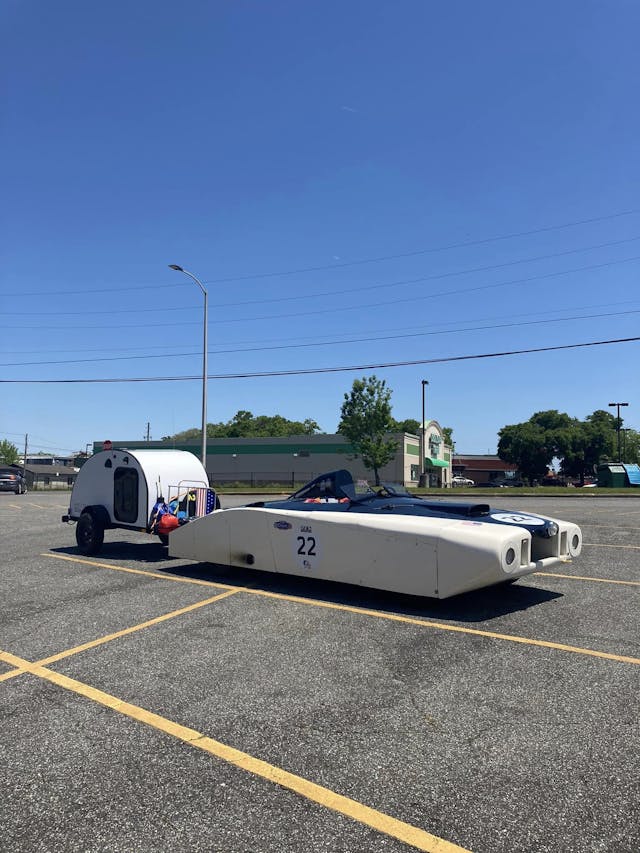
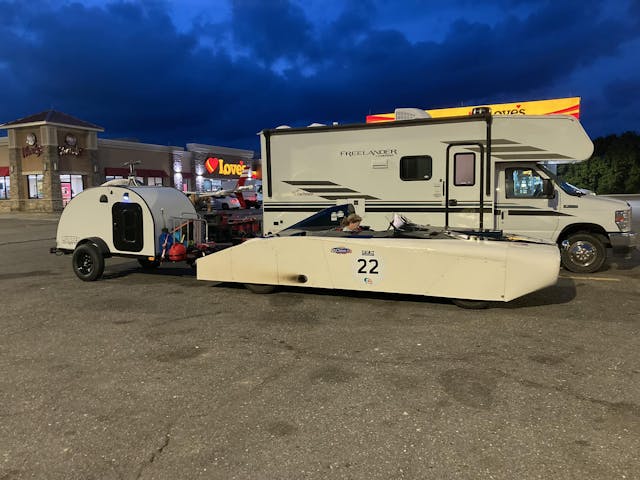
So far, only one thing has gone wrong: A couple of days before our conversation, Drinkwater said he received an email from the vaunted Monterey Historics, held at WeatherTech Raceway Laguna Seca each August. Drinkwater had asked to race there, but he was turned down because his replica of Le Monstre wasn’t, well, Le Monstre.
“They said the car’s not original, and I know it’s not the original car, but underneath, everything is a 1950s short-wheelbase Cadillac. It’s still an historic car, there’s no new aftermarket parts or anything else.” He said there are multiple well-positioned automotive enthusiasts advocating for him, “So I hope we still have a shot.” After all, he said, the event’s first race is even called “The Briggs S. Cunningham Trophy.” Even if he’s refused an entry, he plans to park it in the spectator lot.
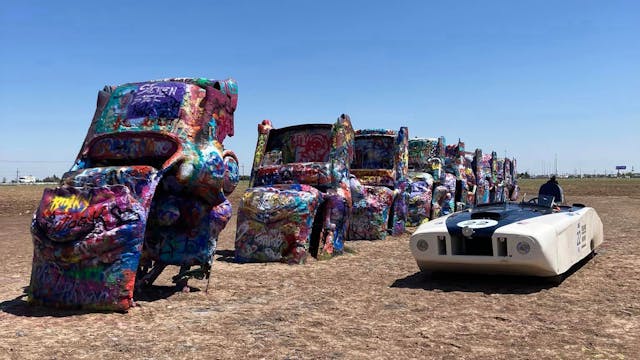
Drinkwater’s car is scheduled to return to England in November, and he and Pat have a lot of America to see between then and now. A couple of days ago, he checked in to their Instagram account from the Cadillac Ranch in Amarillo, Texas. It was colorful.
Taking a year off doesn’t mean they’ll be relaxing. On the morning we spoke, Drinkwater and Pat had spent nearly two hours using the free internet at McDonald’s updating their social media accounts and returning texts and emails.
“The response has been fabulous,” he said. “The way people slam on the brakes to take a video of us on the freeway, I’m sure there’s going to be an incident.”

***
Check out the Hagerty Media homepage so you don’t miss a single story, or better yet, bookmark it. To get our best stories delivered right to your inbox, subscribe to our newsletters.
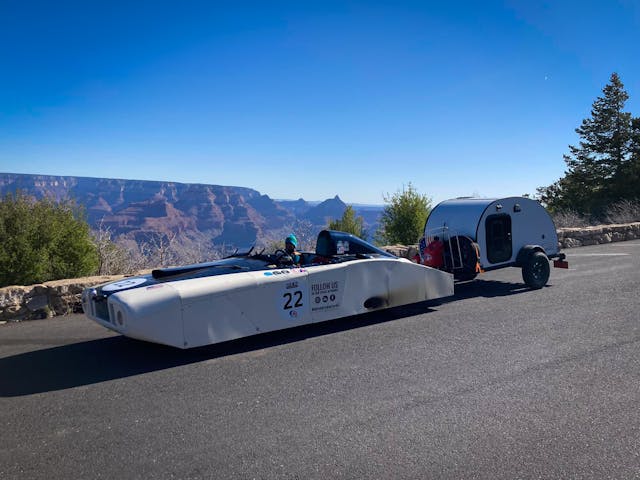

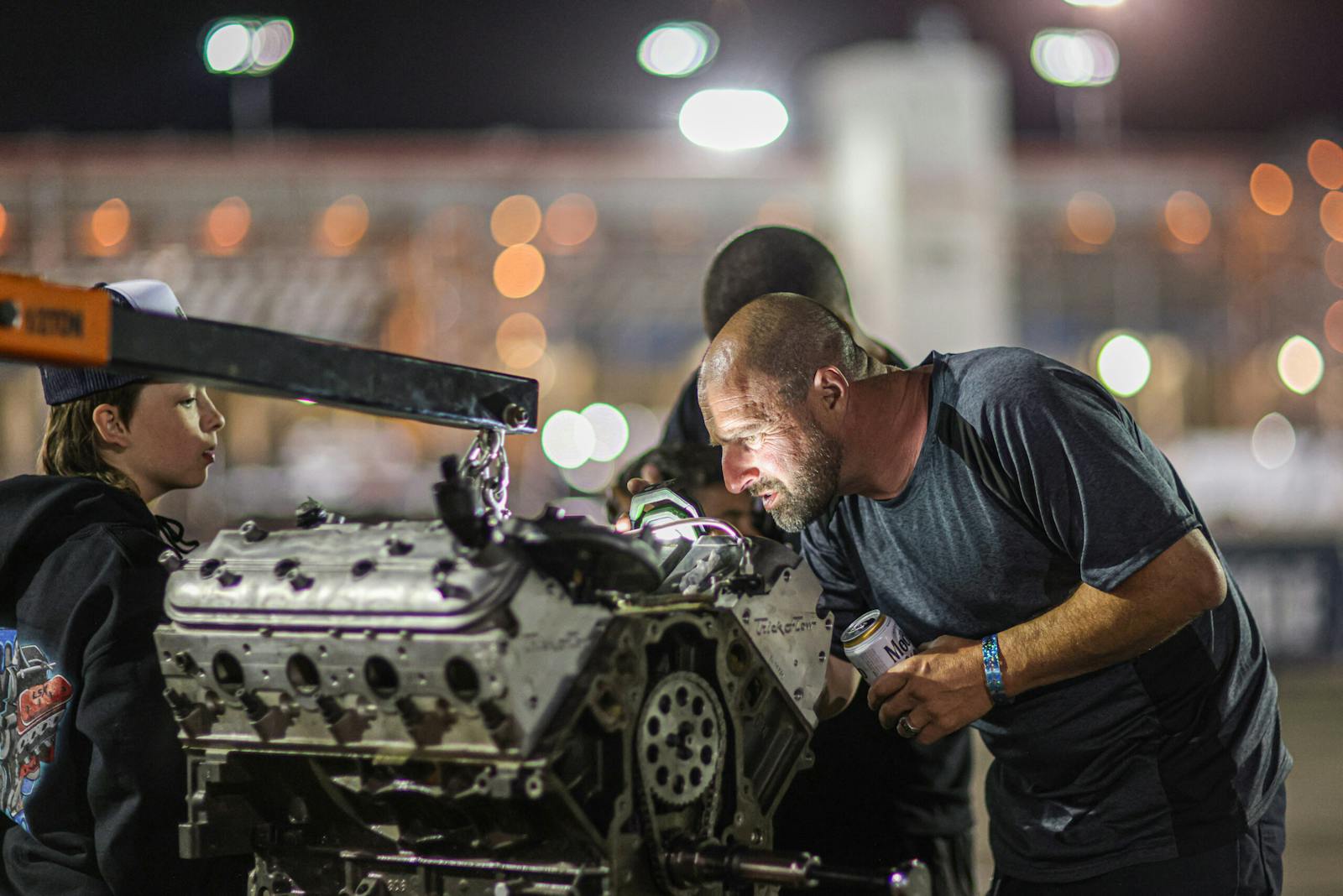
I admire the effort and I hope they change their mind in August and let him race, They will be cheating the fans of something they will never see the other car do Race.
I thought people like those that run the Monterey Historic races were only found in HOA Boards. Not that regulations aren’t important, but sometimes there are exceptions to the rules that just makes things better. This whole situation feels like Burt Munro in his 1967 speed attempt at Bonneville. Does anyone else smell a movie?
This is a great article about a favorite subject. Would anyone in the top brass at The Hagerty Group be interested in buying my hobby website http://www.briggscunningham.com ? I have been working on it for over 15-16 years so please check it out. Best regards, Larry Berman, Cunnigham Motorsport Historian Cell: 617-594-6666
?
Not interested in buying, but you have an excellent website!
That is so cool!!!
Revs Institute museum in Naples is a treasure – reason enough to winter in SWFL
Very cool story. How many (real) vintage race cars do you see not only driving on the street, but pulling a trailer? It was neat seeing pictures of it at the Lone Star Round-Up in Austin.
It looks like it might turn into a flying wing if the wind hits it just right.
If so, it would not be alone, and in fast company as well: https://tinyurl.com/yck8fe9e
My kind of enthusiast!
THIS is a great story! While many of us talk sh&# and dream, this guy is living his!
Yep, what a man. And his wife? Keeper!
Without doing a deep dive into Berman’s Cunningham website is there a quick explanation for the unique numeral painted on Le Monstre?
Very interesting article about a car I had never heard about before – really enjoyed it. Am really interested in the intake manifold/ carburetor setup. Have never seen anything like it and am wondering about the reason for the different center carb and why the unusual layout.
Le Monster raced at Watkins Glen Gran Prix in 1950.
I believe it served more as the pace car than actually competing. I’ve seen footage of the car at WG in 1950 but it’s always shown leading the field in a processional lap
I have several vintage Road and Track magazines reporting Cunningham’s Cadillac adventures at Le Mans–and subsequent attempts with his own Cunningham marque. The only other American car competing at Le Mans then was…wait for it… Crosley!
Fascinating reading!
Poster child for every enthusiast that wants to run a race car on the street.
More power to you Mr & Mrs Drinkwater, I have always known about Le Monstre, but never so much about the technical details.
That’s a shame about Monterey; you can’t tell me that there aren’t some very good replicas of mega-buck Ferraris running incognito during the Historics.
I clicked here thinking it was Le Monstre from REV’s . But not disappointed at all to learn of the builders obsession and skill to replicate this automotive oddity. I do hope Monterey sees it relevant to admit this beauty to the historic race. True car people appreciate this sort of obsession.
Really great piece, love to see real enthusiasts build something so cool and then actually driving it on the roads, and pulling a camper no less!
One minor correction: “the Drinkwaters’ Monstre…” is how the first caption should read. As it is, it’s singular.